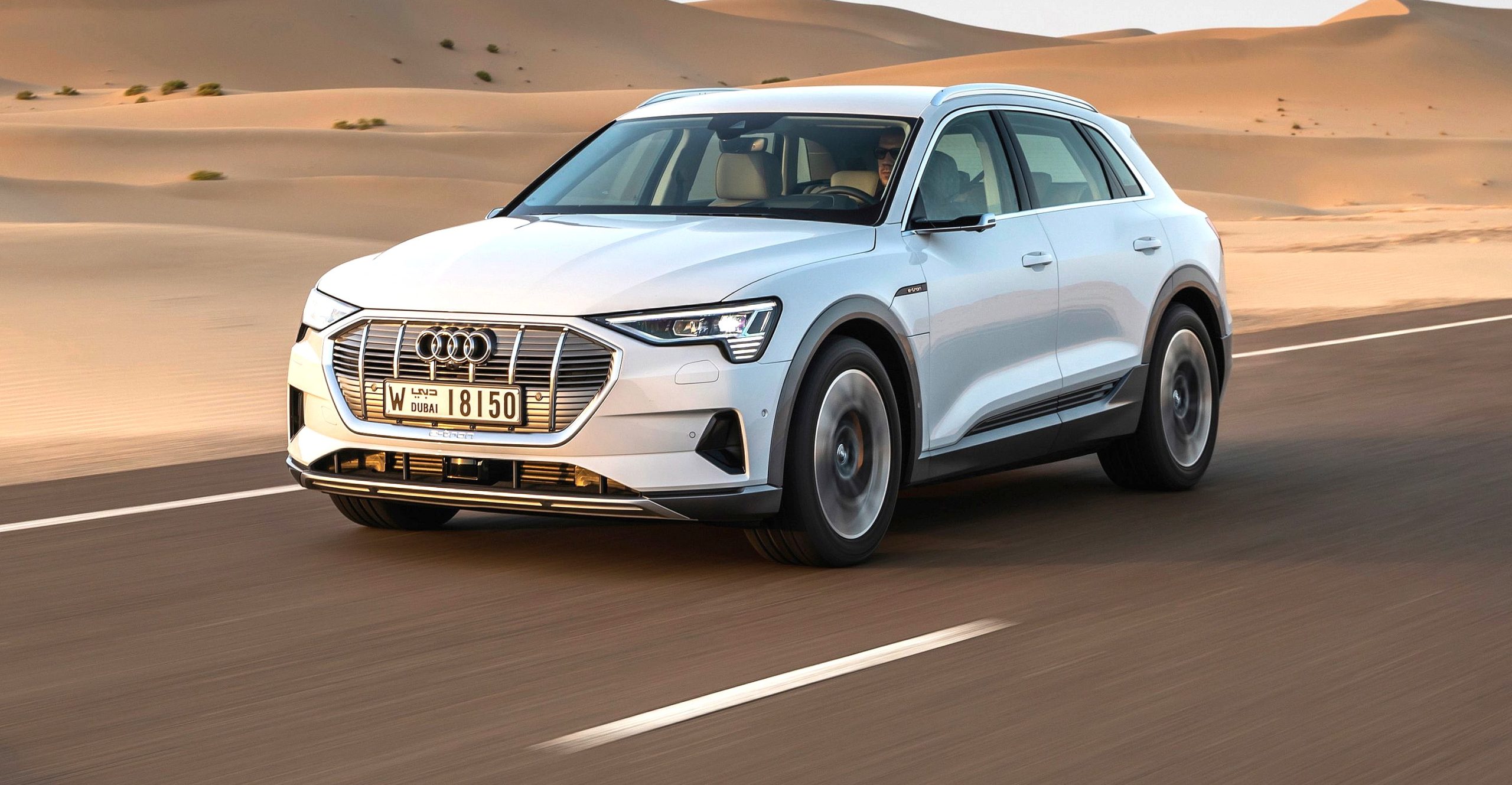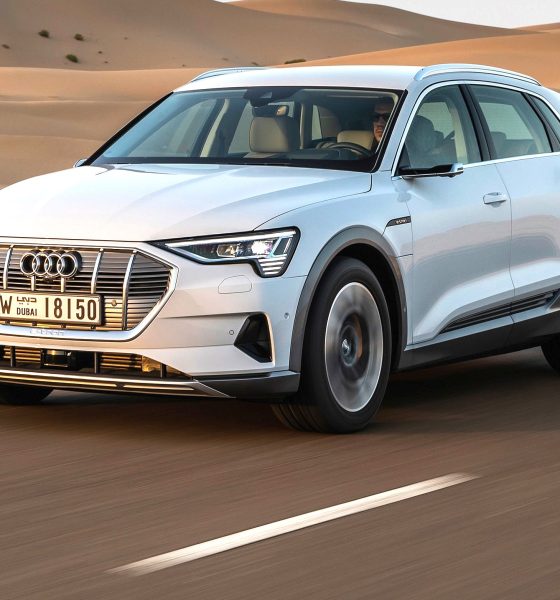

News
Tesla ‘fighter’ Audi e-tron receives glowing first drive review from Consumer Reports
The Audi-e-tron, once dubbed by news outlets as a potential “Tesla Killer” or “Tesla Fighter” recently received its first impressions review from Consumer Reports. Reviewers from the organization proved impressed with the all-electric SUV, noting that the vehicle “takes charge among new EVs.”
Consumer Reports‘ reviewers were particularly impressed with the Audi e-tron’s luxurious amenities such as its high-quality interior and its quietness at highway speeds. This is quite notable, as cabin noise was a point of improvement given to the Tesla Model 3 during the electric sedan’s first impressions review back in February 2018.
The organization also praised the e-tron’s two-screen interface, particularly the SUV’s dedicated screen for its climate system. The displays’ haptic feedback, which simulates the feeling of pressing a physical button, also got the approval of CR‘s reviewers. Nevertheless, reviewers did point out that some of the technology in the e-tron was “needlessly complicated,” as shown in its gear selector, which was not intuitive at all.

Quite interestingly, the e-tron’s rather leisurely acceleration, which was less aggressive than other electric cars such as the Model 3, was dubbed as “appropriate” considering the SUV’s luxury segment. “Unlike some other EVs we’ve recently tested, the E-Tron doesn’t lunge off from a stop; it has a more leisurely rollout. That’s appropriate for a luxury vehicle… On the plus side, there is no spinning of wheels that we have experienced in some other EVs… Once the E-Tron is moving, drivers get smooth and effortless power on demand, at any speed,” Consumer Reports noted.
Considering that the organization has only conducted an initial review of the vehicle, the e-tron’s fast-charging capabilities were not tested. Nevertheless, the organization was optimistic about the vehicle overall, stating that the e-tron has an “air of maturity that exudes quality, and it’s likely because it comes from an established luxury automaker.” Until more tests are conducted, at least, it appears that CR perceives the Audi e-tron as a strong competitor in the growing premium EV segment.
While it is understandable for the organization to not include more details about the e-tron, it is quite interesting to see no mention of the challenges that Audi has and is reportedly facing in bringing the vehicle to market. Currently, reports from reservation holders in Norway have indicated that e-tron deliveries are still delayed, and all units that have been sold so far are presently being recalled due to a fire risk. These details were missing in Consumer Reports‘ initial review.

It should be noted that unlike the e-tron, Consumer Reports‘ first impressions review of the Model 3 included notable sections on the vehicle’s points for improvement, particularly in terms of references to Tesla’s then-ongoing production issues. “Hype has surrounded this car since Tesla CEO Elon Musk first announced it about two years ago, with hundreds of thousands of shoppers placing $1,000 deposits within days. But many of those prospective buyers have had their patience tried, since the Model 3 rollout has been plagued by Tesla’s production headaches and delays,” the organization wrote in its first impressions review last year.
Tesla and Consumer Reports have had a mixed relationship over the years. Take the Model 3, for instance. The organization initially opted to not give the vehicle a “Recommended” rating due to its braking distance, but after Tesla rolled out a software update to address the issue, CR updated its score for the electric car. This February, the organization changed its tone once more, removing the Model 3’s “Recommended” rating after it aggregated reports from owners that listed complaints about issues such as fit and finish. Tesla, for its part, noted that it had already addressed the customer complaints that were aggregated by the organization.

News
Tesla is not sparing any expense in ensuring the Cybercab is safe
Images shared by the longtime watcher showed 16 Cybercab prototypes parked near Giga Texas’ dedicated crash test facility.

The Tesla Cybercab could very well be the safest taxi on the road when it is released and deployed for public use. This was, at least, hinted at by the intensive safety tests that Tesla seems to be putting the autonomous two-seater through at its Giga Texas crash test facility.
Intensive crash tests
As per recent images from longtime Giga Texas watcher and drone operator Joe Tegtmeyer, Tesla seems to be very busy crash testing Cybercab units. Images shared by the longtime watcher showed 16 Cybercab prototypes parked near Giga Texas’ dedicated crash test facility just before the holidays.
Tegtmeyer’s aerial photos showed the prototypes clustered outside the factory’s testing building. Some uncovered Cybercabs showed notable damage and one even had its airbags engaged. With Cybercab production expected to start in about 130 days, it appears that Tesla is very busy ensuring that its autonomous two-seater ends up becoming the safest taxi on public roads.
Prioritizing safety
With no human driver controls, the Cybercab demands exceptional active and passive safety systems to protect occupants in any scenario. Considering Tesla’s reputation, it is then understandable that the company seems to be sparing no expense in ensuring that the Cybercab is as safe as possible.
Tesla’s focus on safety was recently highlighted when the Cybertruck achieved a Top Safety Pick+ rating from the Insurance Institute for Highway Safety (IIHS). This was a notable victory for the Cybertruck as critics have long claimed that the vehicle will be one of, if not the, most unsafe truck on the road due to its appearance. The vehicle’s Top Safety Pick+ rating, if any, simply proved that Tesla never neglects to make its cars as safe as possible, and that definitely includes the Cybercab.
Elon Musk
Tesla’s Elon Musk gives timeframe for FSD’s release in UAE
Provided that Musk’s timeframe proves accurate, FSD would be able to start saturating the Middle East, starting with the UAE, next year.

Tesla CEO Elon Musk stated on Monday that Full Self-Driving (Supervised) could launch in the United Arab Emirates (UAE) as soon as January 2026.
Provided that Musk’s timeframe proves accurate, FSD would be able to start saturating the Middle East, starting with the UAE, next year.
Musk’s estimate
In a post on X, UAE-based political analyst Ahmed Sharif Al Amiri asked Musk when FSD would arrive in the country, quoting an earlier post where the CEO encouraged users to try out FSD for themselves. Musk responded directly to the analyst’s inquiry.
“Hopefully, next month,” Musk wrote. The exchange attracted a lot of attention, with numerous X users sharing their excitement at the idea of FSD being brought to a new country. FSD (Supervised), after all, would likely allow hands-off highway driving, urban navigation, and parking under driver oversight in traffic-heavy cities such as Dubai and Abu Dhabi.
Musk’s comments about FSD’s arrival in the UAE were posted following his visit to the Middle Eastern country. Over the weekend, images were shared online of Musk meeting with UAE Defense Minister, Deputy Prime Minister, and Dubai Crown Prince HH Sheikh Hamdan bin Mohammed. Musk also posted a supportive message about the country, posting “UAE rocks!” on X.
FSD recognition
FSD has been getting quite a lot of support from foreign media outlets. FSD (Supervised) earned high marks from Germany’s largest car magazine, Auto Bild, during a test in Berlin’s challenging urban environment. The demonstration highlighted the system’s ability to handle dense traffic, construction sites, pedestrian crossings, and narrow streets with smooth, confident decision-making.
Journalist Robin Hornig was particularly struck by FSD’s superior perception and tireless attention, stating: “Tesla FSD Supervised sees more than I do. It doesn’t get distracted and never gets tired. I like to think I’m a good driver, but I can’t match this system’s all-around vision. It’s at its best when both work together: my experience and the Tesla’s constant attention.” Only one intervention was needed when the system misread a route, showcasing its maturity while relying on vision-only sensors and over-the-air learning.
News
Tesla quietly flexes FSD’s reliability amid Waymo blackout in San Francisco
“Tesla Robotaxis were unaffected by the SF power outage,” Musk wrote in his post.

Tesla highlighted its Full Self-Driving (Supervised) system’s robustness this week by sharing dashcam footage of a vehicle in FSD navigating pitch-black San Francisco streets during the city’s widespread power outage.
While Waymo’s robotaxis stalled and caused traffic jams, Tesla’s vision-only approach kept operating seamlessly without remote intervention. Elon Musk amplified the clip, highlighting the contrast between the two systems.
Tesla FSD handles total darkness
The @Tesla_AI account posted a video from a Model Y operating on FSD during San Francisco’s blackout. As could be seen in the video, streetlights, traffic signals, and surrounding illumination were completely out, but the vehicle drove confidently and cautiously, just like a proficient human driver.
Musk reposted the clip, adding context to reports of Waymo vehicles struggling in the same conditions. “Tesla Robotaxis were unaffected by the SF power outage,” Musk wrote in his post.
Musk and the Tesla AI team’s posts highlight the idea that FSD operates a lot like any experienced human driver. Since the system does not rely on a variety of sensors and a complicated symphony of factors, vehicles could technically navigate challenging circumstances as they emerge. This definitely seemed to be the case in San Francisco.
Waymo’s blackout struggles
Waymo faced scrutiny after multiple self-driving Jaguar I-PACE taxis stopped functioning during the blackout, blocking lanes, causing traffic jams, and requiring manual retrieval. Videos shared during the power outage showed fleets of Waymo vehicles just stopping in the middle of the road, seemingly confused about what to do when the lights go out.
In a comment, Waymo stated that its vehicles treat nonfunctional signals as four-way stops, but “the sheer scale of the outage led to instances where vehicles remained stationary longer than usual to confirm the state of the affected intersections. This contributed to traffic friction during the height of the congestion.”
A company spokesperson also shared some thoughts about the incidents. “Yesterday’s power outage was a widespread event that caused gridlock across San Francisco, with non-functioning traffic signals and transit disruptions. While the failure of the utility infrastructure was significant, we are committed to ensuring our technology adjusts to traffic flow during such events,” the Waymo spokesperson stated, adding that it is “focused on rapidly integrating the lessons learned from this event, and are committed to earning and maintaining the trust of the communities we serve every day.”








